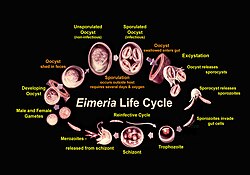Eimeria
 Oocysty Eimeria maxima - tento druh je má mimořádně velké | |
 Životní cyklus | |
| Vědecká klasifikace | |
| Doména | Eukaryota |
| Říše | Chromalveolata |
| Kmen | výtrusovci (Apicomplexa) |
| Třída | Conoidasida |
| Řád | Eimeriida |
| Čeleď | Eimeriidae |
| Rod | Eimeria Schneider 1875 |
| Některá data mohou pocházet z datové položky. | |
Eimeria je rod kokcidií, parazitických prvoků ze skupiny výtrusovců (Apicomplexa). Rozpoznávacím znakem jsou vejčité oocysty o velikosti asi 20 mikrometrů, jež obsahují čtyři sporocysty se Stiedovými tělísky, každá sporocysta se dvěma sporozoity. Rod Eimeria zahrnuje celou řadu významných cizopasníků domácích i volně žijících zvířat.[1]
Životní cyklus se z převážné části odehrává obvykle ve střevě hostitele. Ze sporocysty se sporozoit dostává do hostitelské buňky ve střevním epitelu, roste, množí se a vytváří merozoity, kteří infikují další buňky. Část merozoitů však dospívá v buňkách do mnohojaderných samčích nebo jednojaderných samičích gametocytů. Samčí gamety se následně uvolňují a oplodňují samičí gametocyty přímo v hostitelské buňce. Ta se po úspěšném oplození změní v zygotu a dospívá v oocystu, jež se následně uvolňuje ze střeva do vnějšího prostředí a tam vytváří sporu, jež může napadnout dalšího jedince.[1]
Hostitelé
Eimerie parazitují v poměrně širokém spektru hostitelů. Známé jsou eimerie kura domácího (9 druhů), vyvolávající kokcidiózu domácí drůbeže. Třináct druhů je známo jako původce kokcidiózy králíků (z nichž některé parazitují v játrech a nikoliv ve střevě). Známy jsou i druhy napadající prasata či skot.[1] U lidí nemá tento rod vyšší význam.
Zástupci
- Eimeria stiedai – kokcidie jaterní
- Eimeria zuerni – kokcidie dobytčí
- Eimeria brunetti
- Eimeria tenella
- Eimeria necatrix
- Eimeria acervulina
Reference
Externí odkazy
 Obrázky, zvuky či videa k tématu Eimeria na Wikimedia Commons
Obrázky, zvuky či videa k tématu Eimeria na Wikimedia Commons
Média použitá na této stránce
Autor:
- Information-silk.png: Mark James
- derivative work: KSiOM(Talk)
A tiny blue 'i' information icon converted from the Silk icon set at famfamfam.com
Seven species of Eimeria are known to infect chickens: E. acervulina, E. brunetti, E. maxima, E. mitis, E. necatrix, E. praecox, and E. tenella. Eimeria oocysts vary in size, with E. maxima being the largest (about 20 x 30 microns) and E. mitis the smallest (about 14 x 16 microns). The oocysts are discernable only by use of a compound microscope.
Eimeria Life Cycle


